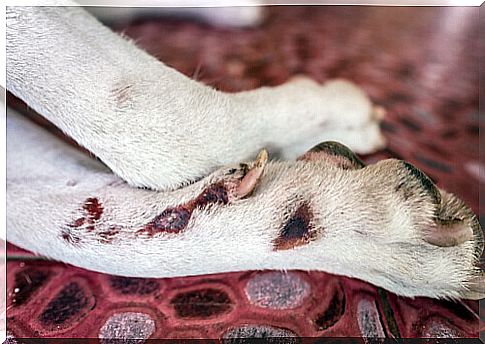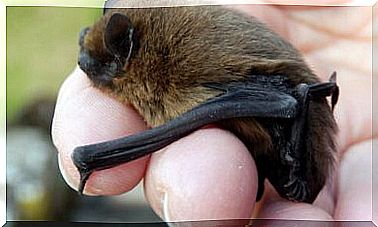Acral Lick Dermatitis In Dogs

Although cats are known to continually groom themselves, dogs also use their tongues to groom themselves. In some cases, the licking is so repetitive or intense that it leads to acral dermatitis. In this article we will tell you what it is and how to treat it.
What is acral dermatitis?
Also known as acral furuncolosis or acral granuloma, it is a chronic disease caused in most cases by the behavior of the dog, which cannot stop licking a specific area. This does not allow the wound to heal completely and it gets worse and worse.
Generally, acral dermatitis begins as a bacterial or fungal infection, an allergy, a cut, or a rash due to an insect bite. In some cases it occurs as a result of boredom or behavior problems of the dog, which licks non-stop in a specific area, mainly the front legs.
When that wound bothers the dog, the first thing it does is try to heal and cleanse itself through saliva. But the problem is that this behavior becomes compulsive and even detrimental to your health.
The cycle seems to have no end, as the animal feels relief from licking, but then needs to do it again when the itching, pain or other symptoms return. And this repetitive behavior turns into acral dermatitis, a much more serious infection than the original.

Although any dog can suffer from this problem when under a lot of stress (which is why it is so common in shelters or kennels), there are some breeds more prone to acral dermatitis. Among them we can highlight the Labrador Retriever, the German Shepherd, the Neapolitan Mastiff, the Golden Retriever, the Doberman Pinscher, the Great Dane and the Spanish Mastiff.
How to identify acral dermatitis?
An acral dermatitis is not difficult to detect, since on the one hand we will see the dog continuously licking or biting a specific area of the body. On the other hand, in that place will appear wounds, hair loss, ulcers, inflammation, sores, bleeding or production of a yellowish liquid. It may also have a foul odor and look bad.
It is very important to take our pet to the vet so that he can make the proper diagnosis. Sometimes it may look like acral dermatitis to the naked eye when it is actually a parasite infection or trauma.
If the professional confirms the disease, the next step will be to identify the cause that has produced it. In this way it can be treated and cured. As a first measure, an antibiotic will be given to reduce the symptoms that lead the animal to lick or bite the area and thus allow healing. Creams or topical treatments can also be applied.
So that the dog does not bite, an Elizabethan collar will be placed on it, although the area can also be bandaged, which must be supervised by the owner. Changing the gauze or cloths will be a challenge, but it must be done with the periodicity indicated by the veterinarian.

When acral dermatitis appears due to a behavior problem in the dog, the family will be recommended to take it out for a walk more, play with it more and pay more attention to it. In this way, you will reduce anxiety and stress and will not have harmful behaviors for your own body.
A healthy and calm environment is essential for recovery and to prevent the condition from occurring again. If acral dermatitis has been caused by the presence of parasites or bacteria, reinforcing vaccines and ensuring good hygiene of the animal will be essential.
You must bear in mind that acral dermatitis is not serious if it is detected and treated early, but the most important thing is that it does not recur in the future. Therefore, detecting the cause is essential, beyond the treatment itself.









